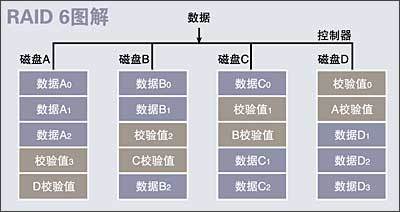Raid translates to Chinese meaning "redundant array of independent disks", in fact, we often say "disk array". This technology allows multiple independent hard disks to be combined into a hard disk group in different ways. The performance of the hard disk group is greatly improved compared to the performance of a single hard disk, and the data recovery function is also provided in the hard disk group. When the hard disk of the computer fails, other hard disks will recover these data, which greatly protects the data security.
Raid translates to Chinese meaning "redundant array of independent disks", in fact, we often say "disk array". This technology allows multiple independent hard disks to be combined into a hard disk group in different ways. The performance of the hard disk group is greatly improved compared to the performance of a single hard disk, and the data recovery function is also provided in the hard disk group. When the hard disk of the computer fails, other hard disks will recover these data, which greatly protects the data security.

(Zhongcheng Tianhe Data Recovery Center)
The hard disk group realized by Raid technology can be regarded as a hard disk, and it can be partitioned and formatted. Therefore, after the appearance of Raid technology, it has been widely used in the server and storage industries, and some simple Raid functions have gradually entered the home market.
In Raid technology, we often hear the word "Raid level". Raid level refers to the combination of hard drives in a disk array. Different Raid levels mean different ways of hard disk combinations. The performance of the disk array provided to users is The performance of security is also different. At present, the common Raid levels are Raid0, 1, 3, 5, 10, 30, 50 and JOBD, etc. There have been many related introductions about this type of Raid level, you can consult more information.
What we are going to talk about today are some uncommon Raid levels. Some of these Raid levels are the direction of future development, and some are the standards proposed by a single company. The Raid levels they propose are better than our common Raid levels in performance and data recovery The ability is strong, so it is also adopted by some companies. We are here to introduce you to these Raid features.
Raid 7
Raid 6 is a private Raid level standard proposed by some large enterprises. Its full name is "Independent Data disks with two independent distributed parity schemes". This Raid level is developed on the basis of Raid 5, so its working mode is similar to Raid 5, the difference is that Raid 5 writes the verification code to a drive, and Raid 6 will verify The code is written to the two drives, which enhances the fault tolerance of the disks. At the same time, there are two faulty disks allowed in the Raid 6 array, but the number of corresponding array disks is at least 4. The figure below is a diagram of Raid 6.

(RAID6 structure)
From the figure, we can see that each disk has two check values, and Raid 5 can only provide one check value for each disk. Since the use of the check value can achieve the purpose of restoring data, there are many Adding a check digit, the stronger the data recovery ability. However, after adding a check digit, a more complicated controller is needed to control it, which also reduces the write capacity of the disk and requires a certain amount of disk space. Therefore, this kind of Raid level application is still relatively small. I believe that with the continuous improvement of Raid 6 technology, Raid 6 will be widely used. The number of Raid 6 disks is N + 2.
The full name of Raid 7 is "Optimized Asynchrony for High I / O Rates as well as High Data Transfer Rates", which is obviously different from the Raid level we have seen before. . Raid 7 can be understood as an independent storage computer, with its own operating system and management tools, it can run independently. The diagram of Raid 7 is as follows:

(RAID 7 structure)
Each "cylinder" in the figure is composed of multiple disks, rather than a disk we have seen before, which represents a "cylinder". From the above picture, we can see that each disk has an independent I / O channel, and they are connected to the main channel. The operating system can directly control the access of each disk, allowing each disk to perform at different times. Data read and write, which greatly improves the application of I / O, and also improves the ability to read and write data, and this disk access method is also called asynchronous access. In Raid 7, a disk is provided as a special verification disk, which is suitable for data recovery of any disk.
In general, Raid 7 is very different from our traditional Raid level. It has many advantages, but the disadvantages are also very obvious, that is, the price is very high, which is not practical for ordinary corporate users.
Raid 5E
Raid 5E is a private Raid level proposed by IBM and has not become an international standard. This Raid level is also developed from the basis of Raid 5. The difference between it and Raid 5 is that the data verification information is evenly distributed on each disk, and each disk must reserve a certain space. Part of the space is not striped (striping refers to the smallest unit of data that is divided into in order to be saved in Raid.
By adjusting the stripe, the performance of the RAID array that supports Raid can be made more excellent). When a disk fails, the data on this disk will be compressed into the space reserved by other disks without striping to achieve the role of data protection, and the Raid level at this time is converted from Raid 5E to Raid 5. Continue to protect disk data. Raid 5E allows two disks to fail, and at least 4 disks are required to achieve Raid 5E. The following figure is a diagram of Raid 5E:

(RAID5E)
Raid 5EE
Raid 5EE is also a private Raid level proposed by IBM, and it has not become an international standard. The working principle of Raid 5EE is basically the same as that of Raid 5E. It also reserves a part of space in each disk as a distributed hot spare disk. When a hard disk fails, the data on this disk will be compressed to the distributed hot spare disk In order to achieve data protection. However, unlike Raid 5E, Raid 5EE adds some optimization techniques to make Raid 5EE work more efficiently and compress data faster. Raid 5EE allows two disks to fail, and requires at least 4 disks to implement.

(RAID5EE)
Raid 1E
Raid 1E is an enhanced version of Raid 1, it is not a combination of Raid 0 + 1 we usually call. The working principle of Raid 1E is basically the same as Raid, except that the data recovery capability of Raid 1E is stronger, but because Raid 1E writes one minute of data at least twice, the load of the Raid processor is strengthened, resulting in disk read Decreased writing ability. Raid 1E requires at least 3 hard drives to achieve. The working principle diagram of Raid 1E and Raid 1 is as follows:
Raid DP

(RAID DP)
Raid DP also belongs to a proprietary Raid standard. It is actually dual Raid 3 technology. The so-called dual Raid 3 technology mainly means that two independent verification disks with different algorithms are formed in the same disk array. The working principle of the disk is the same as Raid 3, but after adding a check disk, the security of the entire disk array is improved, and its performance is better than that of Raid 3 and Raid 5.
Raid ADG
Raid ADG is equivalent to dual Raid 5 technology and is a Raid technology proposed by HP. This technology deploys two parity sets and provides the capacity of two hard drives to store the parity information, which can allow two hard drives to fail at the same time, effectively improving the reliability of the data in the disk. However, this technology will seriously affect the speed of the system, so it has not been promoted.

(RAID ADG)
to sum up
The Raid technology mentioned above is not a standardized technology. Therefore, many manufacturers also define the Raid standard with the same name, but their principles are different. Therefore, when you see these technologies, you must be based on The explanation from the manufacturer side is mainly.
sofas and couches,sectional sofa,sectional couches,modular sofas,eather reclining sofa,recliner sofa set,leather recliner sofa set,leather corner sofa,modern corner sofa
Auxford furniture , https://www.auxfurniture.com